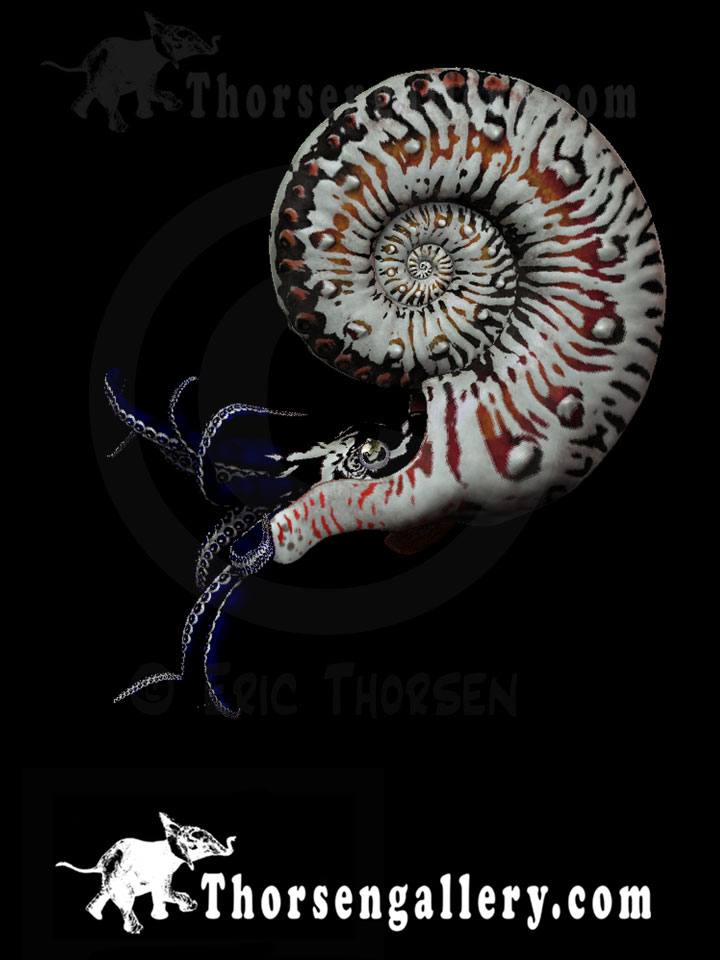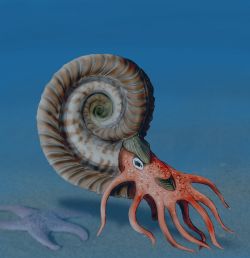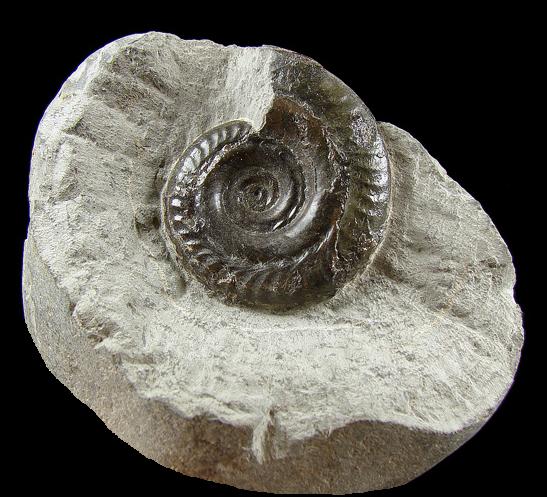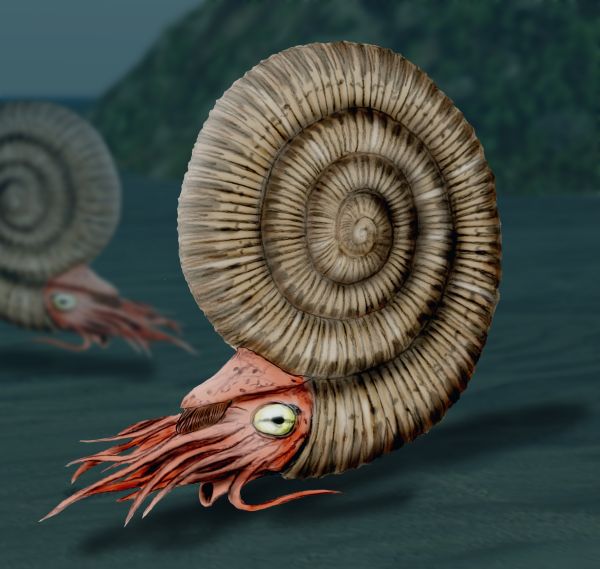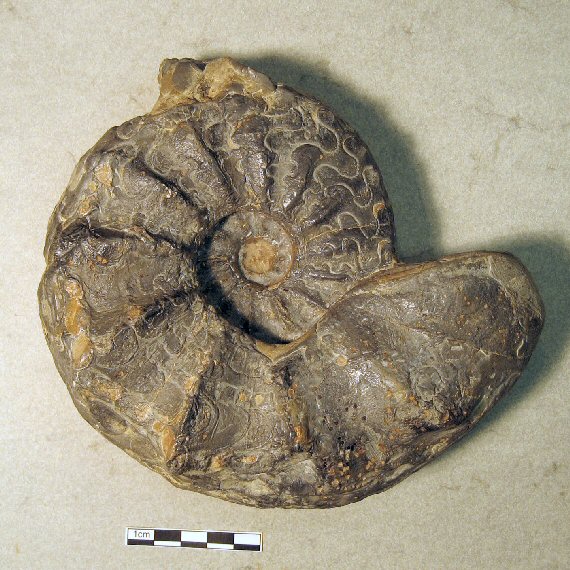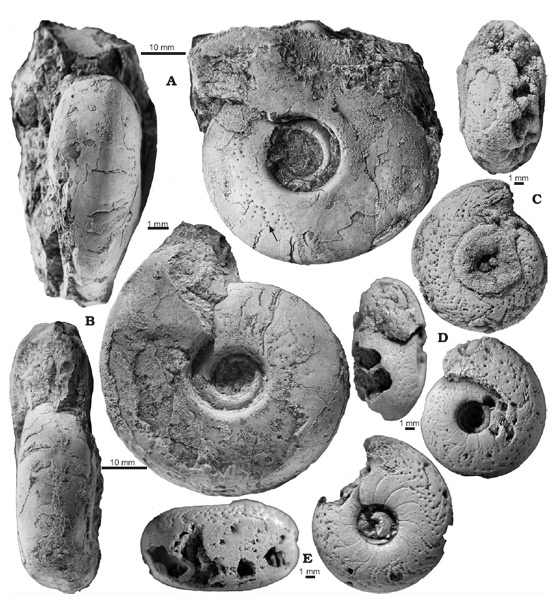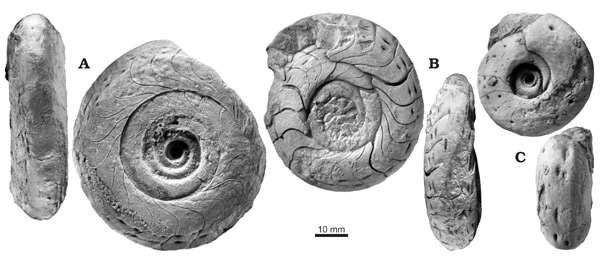[Recent Entries][Archive][Friends][User Info]
Below are 18 entries, after skipping 20 most recent ones in the "Сообщество, посвящённое ра" journal:| February 26th, 2013 | |
|---|---|
| 06:31 pm [industrialterro] [Link] |
Acanthohoplites Acanthohoplites is a Lower Cretaceous ammonite in the family Douvilleiceratidae that has a strongly ribbed shell and ammonitic suture. Early whorls are coronate, which later become round, then oval in section. Primary ribs may have swellings (bullae) at the umbilicus or are without. In early stages primary ribs branch mid flank at prominent lateral tubercles. In later stages lateral tubercles are reduced or absent and primary ribs branch simply at the umbilical shoulder or, again, mid flank. Sutural elements are subquadrate with narrow, shallow embayments. The first lateral lobe tends to be symmetrical. Acanthohoplites has been found in upper Aptian and lower Albian sediments in Europe, Central Asia, Japan, East Africa, Arizona, California, Oregon Mexico, and South America. Parahoplites and Hypacanthoplites are similar genera. The taxonomic position here follows the classification in the Treatise Pt L, 1957. Newer classifications may have revised taxonomies.
Ископаемые останки (1, 2, 3, 4):
Tags: Аммониты, Вымершие беспозвоночные, Мел |
| March 31st, 2012 | |
| 06:36 pm [industrialterro] [Link] |
Peltoceras Peltoceras is an extinct ammonite genus from the aspidoceratid subfamily Peltoceratinae that lived during the later part of the Middle Jurassic (U Callovian). The shell of Peltoceras is evolute with whorls hardly embracing, so that all whorls are mostly exposed. The outer rim, which is known as the venter, aligning with the lower part or belly of the animal, is nearly flat. Inner whorls have strong ribs that bifurcate and trifurcate on the ventral margin. The outer whorls have large simple ribs and two rows of massive lateral tubercles, the outer row developing first.
Ископаемые останки (1, 2, 3, 4):
Tags: Аммониты, Вымершие беспозвоночные, Юра |
| 06:18 pm [industrialterro] [Link] |
Kosmoceras Kosmoceras — род вымерших головоногих моллюсков семейства Kosmoceratidae, подкласса аммоноидеи. Были распространены, главным образом, в Суббореальной области Панбореальной биогеографической надобласти в среднем-позднем келловее (средняя юра). На аммонитах рода Kosmoceras основано зональное расчленение среднего и верхнего подъярусов келловейского яруса. В большинстве разрезов Европы представители рода Kosmoceras исчезают незадолго до конца келловея. Самые поздние Kosmoceras известны из биогоризонта paucicostatum (зона lamberti верхнего келловея) Северного Кавказа. Раковины рода Kosmoceras были покрыты шипами, отличающимися у различных видов по форме — от небольших округлых выступов до тонких иглообразных. Однако данные шипы плохо и очень редко сохраняются в ископаемом состоянии.
Tags: Аммониты, Вымершие беспозвоночные, Юра |
| 06:01 pm [industrialterro] [Link] |
Hildoceras Hildoceras is a genus of ammonite form the upper Lower Jurassic in the family Hildoceratidae. The shells are characterized by a narrow discoidal evolute shape, keeled venter, concave ribs along the outer flanks, and a shallow spiral goove running along smooth inner flanks. Whorls slightly overlap, cross sections are compressed. The ventral keel is bordered on either side by a shallow groove. The genus was named by Alpheus Hyatt after Saint Hilda in 1876, and fossils have been found in Europe and Japan. Род Hildoceras, объединяющий одних из наиболее типичных аммонитов юрского периода, был назван в честь святой Хильды. Самый распространенный вид рода Hildoceras bifrons является руководящим ископаемым: он существовал на протяжении короткого, по геологическим меркам, периода времени и потому дает возможность довольно точно датировать слои горных пород. Его широкая географическая распространенность позволяет проводить детальное сравнение содержащих его слоев и точно указывает на их одинаковый возраст. Эти аммониты отличаются эволютной плоскоспиральной раковиной: каждый новый оборот располагается поверх предыдущего. Сечение оборотов имеет характерную квадратную форму. Интересной особенностью Hildoceras являются простые, серпообразно изгибающиеся, ребра, развитые на боковых сторонах раковины. На боковой поверхности проходит продольная ложбинка, по обе стороны от которой ребра имеют различную ориентацию. Род аммонитов Hildoceras получил наиболее широкое географическое распространение в юрском периоде. Множество окаменелостей этого рода было найдено в Европе, Северной Африке, на Кавказе, в Турции, Иране и Японии. Аммониты, вместе с современными кальмарами и осьминогами, относятся к цефалоподам, или головоногим моллюскам. Основным отличием аммонитов служит их внешний скелет в форме спиральной раковины, тогда как кальмары ограничиваются минимальным внутренним скелетом, а у осьминогов его и вовсе нет. Кальмары и осьминоги также живут в морях и океанах, они весьма умны и охотятся на других водных животных. Вполне вероятно, что их поведение во многом сходно с поведением аммонитов.
Tags: Аммониты, Вымершие беспозвоночные, Юра |
| 05:41 pm [industrialterro] [Link] |
Dactylioceras Dactylioceras was a widespread genus of ammonite from the Jurassic period, approximately 172 million years ago (mya). They are generally small, averaging 65 mm in diameter. Dactylioceras has a strong, ribbed shell. The ribs are slightly inclined forward, running over the outer edge, and either simple or forking at outer end. Though it eventually died out 180 mya, their style of ribbing was copied by numerous subsequent ammonite genera until the whole group became extinct 65 million years ago with the dinosaurs. Dactylioceras probably lived by scavenging on the sea floor. Mass mortality specimens of Dactylioceras are common, and perhaps suggest that these ammonites may often have died shortly after spawning. The dead shells were probably gently washed up into a shell bank on the margins of the Lower Jurassic seas. Flow tank experiments show that Dactylioceras was probably a slow swimmer. Dactylioceras has been collected from almost every continent, and was one of the most successful ammonite lineages ever. They are abundant throughout Europe, with exceptionally fine specimens found in England and Germany. Like many other ammonites, the genus Dactylioceras is extremely important in biostratigraphy, being a key index fossil for identifying their region of the Jurassic. The name Dactylioceras comes from the Greek dactyl, meaning “finger”, and refers to the shell’s branching ribs.
Tags: Аммониты, Вымершие беспозвоночные, Юра |
| 05:32 pm [industrialterro] [Link] |
Asteroceras Asteroceras is an extinct genus of cephalopod belonging to the Ammonite subclass. Asteroceras fossils may be found at Lyme Regis in the Asteroceras obtusum zone of Upper Sinemurian age. Asteroceras is a genus of Ammonites natvie to England durring the Jurassic Era. The genus of Asteroceras included five species, including Asteroceras confusum. Asteroceras fossils were most commonly found in the Lyme Regis, located in Dorset, England.
Tags: Аммониты, Вымершие беспозвоночные, Юра |
| 05:18 pm [industrialterro] [Link] |
Aspidoceras Aspidoceras is an extinct ammonoid cephalopod genus that lived during the Late Jurassic (Kimmeridgian) with a fairly broad distribution. Aspidoceras, named by Zittel, 1868, is the type genus for the persphictacian family Aspidoceratidae and subfamily Aspidoceratinae in which it is included. Aspidoceras has an evolute shell with quadrate-rounded or depressed whorls that have two rows of tubercles, the outer near the middle of the whorl sides. The outer row soon fades in many species. Some species are also ribbed. The venter, or outer rim, is generally wide and broadly arched. Aspidoceras is predated by Euaspidoceras, possibly its ancestor, and is considered related to genera like Orthaspidoceras, Simaspidoceras, and Intranodites.
Ископаемые останки (1, 2, 3, 4):
Tags: Аммониты, Вымершие беспозвоночные, Юра |
| 04:53 pm [industrialterro] [Link] |
Arietites Arietites is a genus of massive, giant evolute, psiloceratacean ammonites in the family Arietitidae in which whorls are subquadrate and transversely ribbed and low keels in tripicate, separated by a pair of longitudinal grooves, run along the venter. Fossils are known world wide from the lower Sinemurian stage of the Lower Jurassic. Similar genera include Megarietites in which the keels are reduced and Epammonites in which the ribs are more closely spaced.
Tags: Аммониты, Вымершие беспозвоночные, Юра |
| December 13th, 2011 | |
| 07:59 pm [industrialterro] [Link] |
Ceratites Ceratites ("Horn Stone") is an extinct genus of ammonite cephalopod that lived in marine habitats in what is now Europe, Asia, and North America during the Triassic. It has a ceratitic suture pattern on its shell.
Tags: Аммониты, Вымершие беспозвоночные, Триас |
| 07:55 pm [industrialterro] [Link] |
Balatonites Balatonites is an extinct cephalopod genus belonging to the ceratitid family Balatonitidae. There are at least four known species: B. balatonicus, B. oyama, B. shoshonensis, and B. zitteli. The shell of Balatonites is essentially evolute, coiled with earlier whorls showing, and is laterally compressed with flattish sides and a roof-like venter. The sides are covered with radial ribs that have tubercles generally arranged in umbilical, median and ventral rows. Balatonites has been found in the Alps, Balkans, Germany, Japan, and Nevada.
Tags: Аммониты, Вымершие беспозвоночные, Триас |
| 07:42 pm [industrialterro] [Link] |
Arcestes Arcestes is an extinct ammonite cephalopod genus belonging to the Ceratitida. Their shells were broad and rounded, giving them an almost spherical appearance. Unlike many other ammonites, the shells of Arcestes lack keels that would otherwise stabilize them while swimming. Because of this, some paleontologists have suggested that they were bottom-dwelling crawlers. The shell of Arcestes is globular or subglobular with periodic narrow transverse constrictions in internal molds due to periodic internal transverse ridges (variaces) in the shell. The suture is ammonitic with complexly subdivided elements. The ventral lobe is subdivided by a low median saddle. Lateral lobes and saddles have generally triangular outlines but are deeply embayed by strong projections forming tree-like patterns. They form a series diminishing in size and complexity in a rather straight line going from the venter to the umbilicus in the middle of the shell. Fossils of Arcestes are found in Mid to Upper Triassic marine strata throughout the world, including California (A. pacificus), Nevada (A (Anisarcestes) mrazici) and Austria (A. intuslabiatus and A. binacostomus).
Tags: Аммониты, Вымершие беспозвоночные, Триас |
| October 23rd, 2011 | |
| 12:27 pm [industrialterro] [Link] |
Cooperoceras Cooperoceras is a genus of the Tainoceratidae, which is part of the Tainocerataceae, characterized by and evolute shell with an open, perforate, umbilicus, sinuous ribs at maturity, and recurved hollow spines along the ventro-lateral shoulders. The flanks and venter are flattened, the flanks converge on the dorsum, the venter has a shallow median groove. The suture is with rounded ventral and lateral lobes. The siphuncle is small, tubular, and subcentral. (Kummel 1964, K413) Cooperoceras, known from the Lower Permian of N America and Europe (Urals), was named by Miller in 1945. The genotype is Cooperoceras texanum. The phylogenetic relationships of Cooperoceras are unclear.
Tags: Аммониты, Вымершие беспозвоночные, Пермь |
| October 21st, 2011 | |
| 08:01 pm [industrialterro] [Link] |
Xenodiscus Xenodiscus is an extinct ammonoid cephalopod genus and one of the earliest ceratites, found in the Upper Permian of northern India and Timor. Xenodiscus is included in the family Xenodiscidae which is part of the ceratite superfamily Xenodiscaceae Xenodiscus has a thinly discoidal and ribbed shell with ceratitic sutures, coiled so all whorls are exposed. The whorl section is subquadrate and compressed, so as to be narrower than high.
Tags: Аммониты, Вымершие беспозвоночные, Пермь |
| 07:54 pm [industrialterro] [Link] |
Uraloceras Uraloceras is an ammonoid cephalopod genus belonging to the goniatitid family Paragastrioceratidae. The genus was named by Ruzhencev 1936 and is a jr. synonym of Pseudogastrioceras Spath 1930 according to Miller, Furnish and Schindeworlf, 1957. More recent classifications however list the two as distinct genera and put Uraloceras in the Paragastrioceratinae and Pseudogastrioceras in the Pseudogastrioceratinae. Uraloceras, which comes from the Permian, is involute with a small to medium umbilicus and rounded venter. The shell is covered by longitudinal ribbing or coarse lirae. The suture, as characteristic of the family, has eight lobes, of which only the ventral one is bifurcate.
Tags: Аммониты, Вымершие беспозвоночные, Пермь |
| October 1st, 2011 | |
| 05:54 pm [industrialterro] [Link] |
Aenigmatoceras Aenigmatoceras is a genus of ammonite cephalopod from the Carboniferous of Russia. It is tentatively placed within the family Cravenoceratidae based on similarities with Tympanoceras.
Tags: Аммониты, Вымершие беспозвоночные, Карбон |
| 05:39 pm [industrialterro] [Link] |
Goniatite Goniatites are extinct ammonoids, shelled cephalopods related to squid, octopus, and belemnites, that form the order Goniatitida. The Gonatitida originated from within the more primitive anarcestine ammonoids in the Middle Devonian some 390 million years ago. Surviving the Late Devonian extinction, goniatitids flourished during the Carboniferous and Permian only to become extinct at the end of the Permian some 251.4 million years ago. They were survived by their cousins the ceratite ammonoids, indirect descendants of the Anarcestida. The goniatites all possessed an external shell, which is divided internally into chambers. The animal lived in the largest of the external chambers, and the internal chambers would have been filled with gas, making the animal buoyant in the water. The general structure of the goniatites would have been similar to that of their relatives the ammonites, being a free swimming animal possessing a head with two well developed eyes and arms (or tentacles). Goniatite shells are small to medium in size, almost always less than 15 centimeters (6 inches) in diameter and often smaller than 5 centimeters (2 inches) in diameter. The shell is always planispirally coiled, unlike those of Mesozoic ammonites in which some are trochoidal and even aberrant (called heteromorphs). Goniatitid shells vary in form from thinly discoidal to broadly globular and may be smooth or distinctly ornamented. Their shape suggests many were poor swimmers The thin walls between the internal chambers of the shell are called the septa, and as the goniatite grew it would move its body forward in the shell secreting septa behind it, thereby adding new chambers to the shell. The sutures (or suture lines) are visible as a series of narrow, wavy lines on the surface of the shell. The sutures appear where each septa contacts the wall of the outer shell. The typical goniatitid has a suture with smooth saddles and lobes, which gives the name "goniatitic" to this particular suture pattern. In some the sutures has a distinctive "zigzag" pattern Not all goniatitid ammonoides have goniatitic sutures. In some the sutures are ceratitic, in others, even ammonitic. Nor are goniatitic sutures limited to the Goniatidia. The sutures of nautiloids are by comparison somewhat simpler, being either straight or slightly curved, whereas later ammonoids showed suture patterns of increasing complexity. One explanation for this increasing extravagancy in suture pattern is that it leads to a higher strength of the shell. Ecologically, goniatites were limited to environments of normal-marine salinity—as appears to be the case for all cephalopods throughout their history. Goniatites are much more abundant and speciose in rocks understood to represent cratonic (also called epicontinental or inland) sea sediments than they are in rocks understood to represent open ocean sediments. Within these inland seas, goniatites' greatest abundance and diversity appears to have been achieved in offshore deep ramp and basinal environments rather than in nearshore environments. Known nearshore (e.g., lagoonal) occurrences have generally been ascribed to wash-in of shells from offshore waters. Due to lack of strong evidence for any particular life mode (e.g., nektonic, planktonic, demersal, planktivorous, piscivorous), it remains unclear what resources goniatites were capitalizing on in these offshore environments. Only a few goniatites' full trophic apparatuses have ever been described, and reports of stomach contents in these creatures' fossils remain questionable at best. However, goniatites clearly lacked the calcified jaw apparatuses developed later in ammonoid history by the ammonites; this has been cited as evidence against a durophagous (shell-crushing) diet for goniatites.
Tags: Аммониты, Вымершие беспозвоночные, Карбон |
| September 16th, 2011 | |
| 08:59 pm [industrialterro] [Link] |
Clymeniida The Clymeniida constitute a unique order of ammonoid cephalods from the Upper Devonian characterized by having an unusual dorsal siphuncle. They measured about 4 cm in diameter and are restricted to Europe, North Africa, and possibly Australia. Clymeniids produced a variety of shells ranging from smooth to ribbed and spinose and from evolute with all whorls exposed to strongly involute with the last whorl covering the previous. Some were even triangular as viewed from the side (along the axis of coiling). With the exception of the first few chambers, all have a siphuncle that runs along the dorsal margin, along the inside of the coils, opposite that of most ammonoids. The siphuncle starts off ventrally, like that in other ammonoids, but after the first few septa migrates to a definite and stable dorsal position. Septal necks are retrosiphonate, characteristic of their nautlloid ancestors, and are commonly very long, forming an almost continuous siphunclular tube. Septa, characteristic of ammonoids, are convex toward the front.
Tags: Аммониты, Вымершие беспозвоночные, Девон |
| 08:34 pm [industrialterro] [Link] |
Agoniatitida Agoniatitida, also known as the Anarcestida, is the ancestral order within the cephalopod Subclass Ammonoidea, that lived in what would become Africa, Asia, Australia, Europe, and North America during the Devonian from about 410—385 mya, existing for approximately 25 million years. Agoniatitida are primitive ammonoids with a ventral retrochoanitic siphuncle (septal necks point to the rear) reflective of their nautiloid ancestors.and goniatitic sutures with a variable number of lobes. Shells vary from discoidal to globular. Coiling may be loose with whorls barely touching or tight with a dorsal impression.
Tags: Аммониты, Вымершие беспозвоночные, Девон |












